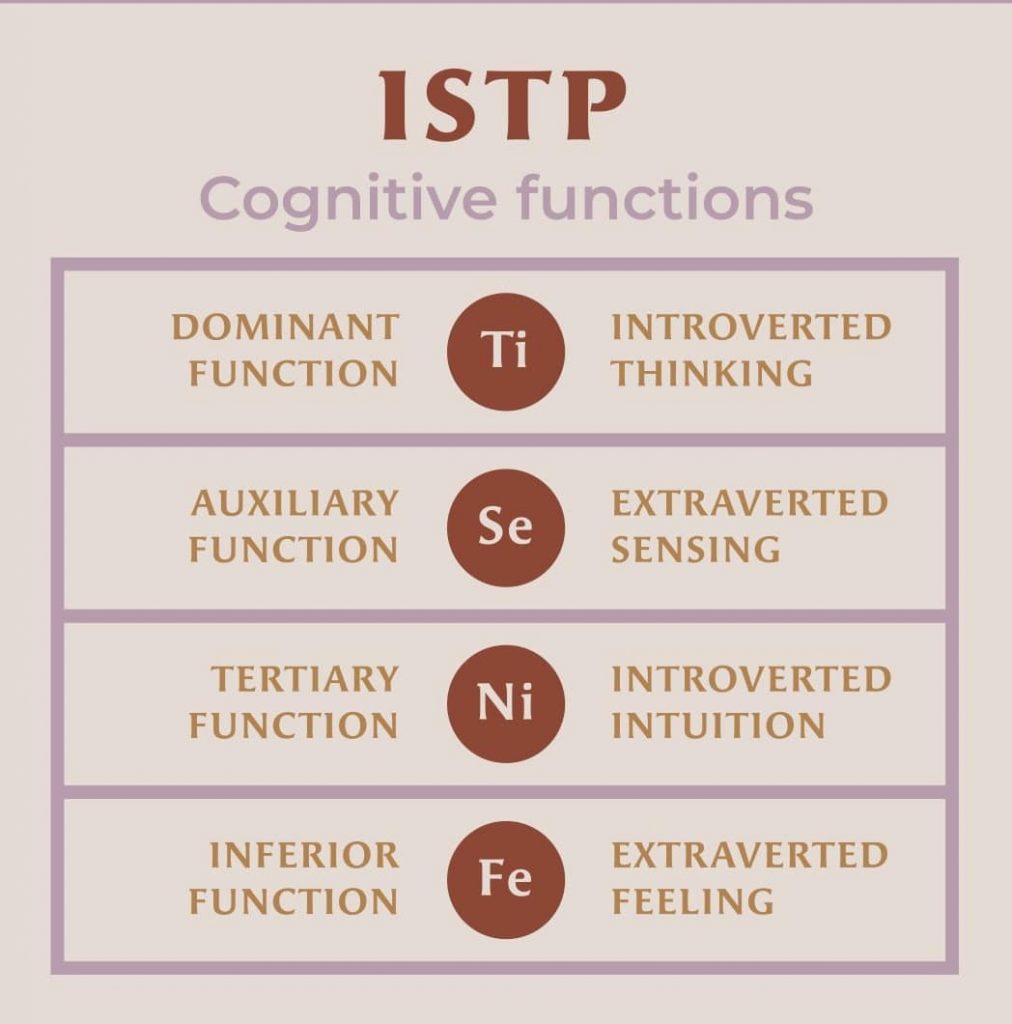ISTP
Contents
General:
The ISTP consists of Introvert, in that they energize themselves by looking inwardly and through intense introspection, Sensing, in that they prefer to use information obtained directly through the five senses, Thinking, in that they reason using objective and logical data and analysis; as well as Perceiving, in that they are not rigid or necessarily organized in any given approach, and prefer to work with new information as it presents itself. Other names for the ISTP can include the Analyzer, the Artisan, the Crafter, and the Logical Pragmatist. The ISTP consists of approximately 5 percent of the population, and it is much more common amongst men at 9 percent, versus a meager 2 percent of women reporting in as ISTP.
ISTPs have an efficient and precise mind. They are not particularly interested or vested in other people and instead prefer the world on their terms. ISTPs are rabid in their analysis and are constantly processing and scrutinizing the world around them. Given their Introversion, the ISTP often tends to have small social circles with a trusted few with whom they often share values, interests, and hobbies.
Given their Perceiving preference, they also do not enjoy or seek out organization or structure in their lives, whether it be professionally or personally. The ISTP instead prefers spontaneity and follows opportunity and thought as it presents itself. ISTPs like facts, figures, and the world that they can see and experience hands-on. Given this, they are not particularly inclined towards the abstract or theoretical realms, as, to the ISTP, it poses little to no practical value and is not worth the time and attention.
ISTPs are usually very technical in their thoughts, approach, and expression and show a propensity and deep understanding of machines and machinery. While this technical approach is undoubtedly useful and valuable, ISTPs can also come across as insensitive and unemotional in their process.

ISTP as Direct Reports:
ISTPs are an asset to any given team and bring various unique and valuable skills and ways of thinking. They are analytical to the extreme and always love to apply it to any new idea or project. Given their preference for Introversion, ISTPs primarily prefer a work environment that is quiet with little required interaction with others. They like little to no supervision of their work and resent overbearing leaders. They enjoy following their lines of thought and thinking to see where they lead and what value it can produce. This is an important trait. However, it is not necessarily conducive in environments that are strict and rigid. Given their Perceiving preference, the ISTP prefer work environments where the workplace does not have a heavily enforced structure or order.
ISTPs will work and collaborate with others when necessary. However, they have little patience for those who do not show the same affinity and appeal to reason as they do, and the ISTP has little hesitation in making this frustration known. They can also be swift to discount the thought and ideas of others that they do not think to have value or that do not have a sense of practicality. ISTPs are action-oriented and do not see the value in spending too much time planning or theorizing the line of execution or plan of attack. Instead, they can be almost irate when the most logical and practical path forward is already established and not followed immediately. ISTPs are most comfortable and at ease when left to their own devices and when they do not need to rely upon the assistance or contributions of others.
ISTP as Leaders of Others:
As leaders, ISTPs are somewhat detached from their team in that they will provide the overall direction and little else. It is, therefore, up to the team to execute and implement it. This works well within the context of groups that consist of those that thrive with little direction and do not need to know the how or the why; however, it quickly becomes an issue for those on a team who may not appreciate this hands-off approach. ISTPs are results-driven and prefer environments where they can see immediate results from their team’s performance. Professions or careers where their results are less immediate may, in fact, frustrate the ISTP.
ISTP Professions:
Ideal careers for the ISTP include those that are hands-on and mechanical but also require a degree of creativity. These can consist of professions such as a Carpenter, a Mechanic, a Forester, a Chef, a Machinist, an Economist, a Systems Analyst, a Software Developer, an Electrical Engineer, a Plumber, a Mechanical Engineer, a Civil Engineer, an Architect, as well as many others. However, it is essential to note that this does not mean that the ISTP will be instantly successful and excel in these professions. Instead, it is to say that these professions are most compatible with the values and styles of the ISTP, which therefore creates a conducive environment for professional growth and accomplishment.
And, just as there are compatible jobs for the ISTP, so are there potentially incompatible jobs that the ISTP should consider before undertaking. These are careers and professions which are particularly people-focused and which are more in the realm of Feeling rather than Thinking and include Therapist, Social Worker, Receptionist, and Actor, to name a few. Again, this is not to say that the ISTP cannot be successful at these roles, but rather, they may find it challenging from an engagement level and when it comes to their overall job satisfaction.
ISTP and Interpersonal Relationships:
ISTPs tend to leader very private and reserved lives, and the ISTP only lets a very select few into their inner social circle. ISTPs may be reserved. However, they are profoundly adventurous and demonstrate a particular interest and affinity towards risk-taking behavior. Similar to their ESTP counterparts, the ISTP can be perceived as a thrill-seeker by some. In fact, ISTPs tend to lead a particularly hedonistic lifestyle, given their preference for Sensing and Perceiving.
As such, the ISTP is compatible with similar personality types that enjoy all that the world has to offer as much as they do. They do not appreciate, nor do they have much in the way of patience for, those who criticize or judge their lifestyle. Also, ISTPs can be rather blunt and direct in their communication with others. They tend to be a more challenging personality type for the more Feeling personality types and those that can be considered overly sensitive.

ISTP in Friendships:
The ISTP prefers and seeks out others who are as enthusiastic, analytical, and spontaneous as themselves. On a fundamental level, the ISTP is most compatible with other Sensing personality types, as their method towards taking in and perceiving the world is fundamentally similar. The most compatible personality types for the ISTP include the ISTJ (Introvert, Sensing, Thinking and Judging), the ISFP (Introvert, Sensing, Feeling and Perceiving), the ESTP (Extravert, Sensing, Thinking and Perceiving), as well, of course, as other ISTPs.
However, similar to personality types and professions, such is the case with personality types and relationships. This is not to say that these personality types will automatically and instantly get along, but, instead, it is to say that they both show similar interests, perspectives, and values of the world on a fundamental level. This commonality provides fertile ground for bonding and creating lasting relationships.
And, just as there are compatible relationships, the same follows for incompatible relationships as well. The ISTP is most challenged by those that have a tendency for those that are Intuitive by nature, and include the INFP (Introvert, Intuitive, Feeling and Perceiving), the INFJ (Introvert, Intuitive, Feeling and Judging), the ENFP (Extravert, Intuitive, Feeling and Perceiving), and lastly the ENFJ (Extravert, Intuitive, Feeling and Judging).
Again, it is essential to reiterate that this does not necessarily mean that these personality types will not necessarily get along or clash. However, it is to say that both personality types may find it difficult to bond and relate based on the fundamental difference in their personality types. With effort and awareness, these relationships could be advantageous. However, they may take more work and action than with the other personality types.
ISTP in Romantic Relationships:
In a romantic relationship, the ISTP is passionate and engaged. They seek out a partner who shares their same lust for life and vivacity. Given their Introversion, they also prefer a partner who appreciates and understands their need for space and time to be on their own. Also, given their propensity for Thinking over Feeling, they may appear emotionally unavailable to their partner, which can be particularly difficult for the more Feeling personality types.
Also, given the ISTP’s thrill-seeking and hedonistic lifestyle, they must be careful once they leave the ‘honeymoon’ period of the relationship and the novelty wears off. Like their ESTP counterparts, they should be open and communicative about their needs and wants within the relationship and where they see the relationship going. However, this is especially difficult for the ISTP as they are not necessarily comfortable in planning ahead, especially when it is consists of planning ahead for feelings.
ISTP and Families:
The ISTP tends to make a great parent, especially when their children show similar interests and preferences as themselves. The ISTPs prides themselves on passing down knowledge and know-how, especially when it is anything mechanically related. They enjoy tinkering with objects and projects and genuinely appreciate when their children show a genuine interest in the process. This combined interest provides the ISTP an opportunity to engage and bond with their children. However, as the ISTP tends to avoid conversations involving feelings and emotions, this can be particularly difficult for children of an ISTP who do not share similar interests and who tend more toward Feeling than Thinking. Therefore, the ISTP must realize if this is indeed the nature of their relationship and adapt accordingly, lest the child feel neglected, and a rift is created.
Conclusion:
Thus, it is unsurprising how the ISTP earns such names as the Analyzer and the logical Pragmatist. They are outwardly reserved and tend to keep their social circles small, given their tendency towards Introspection. And, although reserved, they are fun-loving, adventurous thrill-seekers who have a passion and lust for living in the here and now. They are hedonistic in nature and can be perceived as perhaps overindulgent by some. In the workplace, they prefer to be in complete control of their task and prefer to work within the realm of the technical and practical, as opposed to the more abstract and theoretical realms. In relationships, the ISTP tends to prefer Thinking over Feeling, and may come across as emotionally unavailable, blunt, and cold. This perception can ultimately have adverse effects if not realized and acted upon accordingly, especially with those personality types who are more Feeling in preference. In a family context, the ISTP enjoys and prides themselves on passing down their technical and practical knowledge, especially when the child is receptive and shows an aptitude and eager interest.







